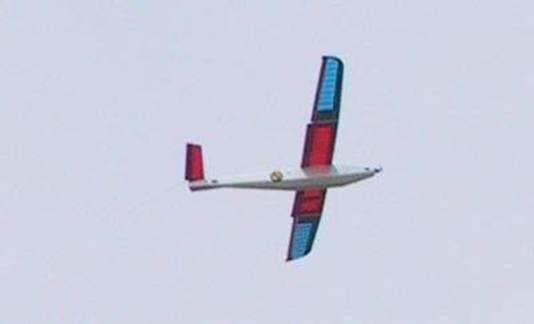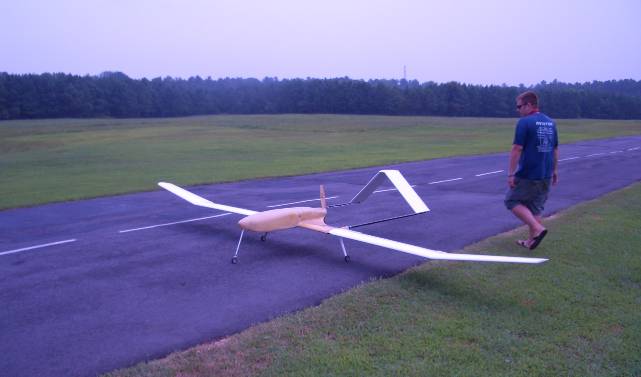Fuel cell powered flight

In November 2005, the Naval Research Laboratory (NRL) flew a 5.6-pound ‘Spider-Lion’ micro UAV for three hours, 19 minutes, with a Protonex fuel cell power system, fuelled by compressed hydrogen, as the sole source of power, for the duration of the flight.
The UAV and fuel cell were developed by Protonex Technology Corporation, a leading manufacturer of high-performance fuel cell power systems, for portable and remote applications.
Small Unmanned Aircraft Surpasses Its Own Record Flight Time
from http://www.fuelcellsworks.com/Supppage8533.html
Publication Date: 11 Mar 2008
SOUTHBOROUGH, MA --Protonex Technology Corporation , a leading provider of advanced fuel cell power systems for portable, remote and mobile applications, today announced that the U.S. Air Force Research Laboratory (AFRL) and development partner AeroVironment, Inc. have documented yet another successful, record flight on a small, unmanned aerial vehicle (UAV) utilizing a highly advanced fuel cell system from Protonex. AeroVironment's "Puma" UAV system broke its previous flight record of over seven hours and flew continuously for over nine hours, powered by the latest generation of Protonex' Pulse UAV power system.
The 9+ hour duration of the Puma flight using Protonex fuel cell power far surpasses the longest previous Puma flight achieved by AeroVironment using any technology. By incorporating the Protonex power system, the Puma was able to demonstrate three to four times the endurance capability of its standard batteries. The Pulse UAV system used in the Puma demonstration is a high performance, ultralight fuel cell system, coupling fuel cell technology that can achieve 1,000 watts per kilogram with an advanced chemical hydride fueling technology developed by Millennium Cell, Inc. to increase energy density.
With the successful completion of this major milestone, Protonex is planning to focus on transitioning this advanced power source into small UAV products with specific payloads and mission requirements for both military and commercial applications. The endurance capabilities proven in this program were previously achievable only with larger scale, more costly UAV platforms. Now, it's expected that new missions such as surveillance, search and rescue, chemical-biological monitoring, and other long-endurance specialty missions can be achieved by smaller, more cost-effective UAV platforms that incorporate Protonex' advanced power systems.
"Increased endurance and payload capacity are critical capabilities that are not feasible with current battery technology being used in small unmanned aerial vehicles today," stated Dr. Paul Osenar, Chief Technology Officer, Protonex. "The final, successful extended duration capability demonstrated through this program with AFRL and AeroVironment yields significant opportunity for Protonex to enable new missions with small UAVs that are faster to deploy at considerably less cost for a wide range of military and commercial applications."
Korean Scientists Build Fuel Cell-Powered Unmanned Aircraft
from http://english.chosun.com/site/data/html_dir/2007/10/10/2007101061024.html
A team of Korean researchers has developed an unmanned aerial vehicle, or drone, capable of flying more than 10 hours on one charge of its hydrogen fuel cell.
The team from the Korea Advanced Institute of Science and Technology (KAIST) led by Prof. Kwon Se-jin and Shim Hyun-chul from the department of aerospace engineering said on Tuesday that they succeeded in fitting out the small drone with a fuel cell and that it performed a long-term flight.
Water can be separated into hydrogen and oxygen by using an electrical current. A hydrogen fuel cell, on the other hand, produces electricity through a chemical reaction between hydrogen and oxygen. Last year a joint research team from the U.S. Naval Research Laboratory and Georgia Institute of Technology developed a drone that uses compressed hydrogen gas to lengthen its flight time.
According to Prof. Kwon, sodium borohydride, the liquid fuel used in the fuel cell, can produce more hydrogen than hydrogen gas and is also more convenient for commercialization. The hydrogen fuel cell produces about 10 times more electricity than existing batteries, making it an attractive power source for robots and digital cameras.
The team's drone measures 1.2 m wide and 0.7 m high and weighs 2 kg, including the 750 g fuel cell system. That's about the same size as U.S. military drones. With 500 grams of fuel, the fuel cell drone can fly more than 10 hours.
"The research team is consulting with Korea Aerospace Industries and Uconsystem, aiming at commercializing the hydrogen fuel cell within two years," Prof. Kwon said. The researchers plan to develop an automatic flight control system that will allow the drone to remain in the air for extended periods.
Horizon Fuel Cell Powers New World Record in Unmanned Aircraft Flight
2 November 2007 – 8:56 am by FIDSNS
from http://www.horizonfuelcell.com/file/Pterosoardistancerecord.pdf
Horizon Fuel Cell Technologies of Singapore announced today that a new hydrogen fuel cell propulsion system it designed enabled a small unmanned aerial vehicle (UAV) flight which was 50% longer than the previous distance record for micro UAV’s. The fuel cell integrated micro UAV, which was designed by two leading U.S. aerospace research laboratories and supported by NASA, the Dryden Flight Research Center, the U.S. Air Force Office of Scientific Research and the National Science Foundation, set a new micro-UAV flight distance record of 78 miles (128 km) in Lancaster, California, xceeding by 28 miles (40 km) the previous record set in 2006 in Estonia. Even more significant is that this flight record was achieved using only 25% of the hydrogen tank capacity stored on-board the aircraft. On a full tank of fuel, the aircraft’s flying range is 500 km (310 miles), enabling flights that are several times longer than previously recorded.
Horizon’s new ultra-compact hydrogen fuel cell propulsion system creates high-efficiency electrical power by reacting hydrogen and oxygen from the air without combustion. Fuel cells enable longer flight times, quieter operation, less heat signature, and higher reliability than batteries or other methods of propulsion for many UAV’s. So far however, very few fuel cell systems have been able to meet the extremely stringent size and weight requirements of UAVs. At over 480 Watt hours per kilogram, or 2.6 times the energy density of the best available batteries. Additionally, Horizon offers the best known system power and energy density specifications in a fuel cell based propulsion system, which can greatly extend the flight range of existing small UAV’s.
The UAV project named “Pterosoar,” was the result of a joint-effort led by Principal Investigators Dr. Maj Mirmirani, Dean of the Mechanical Engineering Department at California State University of Los Angeles (fuel cell system testing and integration) Dr Andy Arena of Oklahoma State University Aerospace Engineering Laboratory (fuel cell aircraft development) Horizon Fuel Cell Technologies (fuel cell system) and Temasek Polytechnic of Singapore (system control electronics). The name “Pterosoar” was adopted and adapted because the nose of the aircraft includes some fuel cell cooling scoops that make the airplane resemble a class of prehistoric creatures named Pterosaurs.
Members of the Pterosoar team included Christopher Herwerth of Calstate LA’s Multidisciplinary Flight Dynamics Laboratory, who started working on fuel cell flight as early as 2005, and achieved a successful Horizon-powered test- flight as early as August 2006. This time, the new distance record was achieved using a fully integrated fuel cell aircraft designed by the OSU Aerospace Engineering Laboratory, which presented the additional challenge of weighing 10.2 lbs (5kg), including hydrogen and fuel cells. To fly 78 miles, the aircraft consumed only 25% of the energy available on-board using a pressurized hydrogen tank. In the next few weeks, the same aircraft is expected to exceed 15.5 hours of flight, setting a new world endurance record for small-size unmanned planes.
Horizon’s fuel cell capability was also demonstrated earlier this year as it powered the 200km/h Hyfish jet-wing UAV designed by Smartfish GmbH in Switzerland and integrated by the German Air & Space Institute (DLR). This program is unrelated to the micro-UAV flight discussed above, but offers a glimpse of Horizon’s potential to break new ground in the pioneering field of aerospace.
First flights of Unmanned Aircarft powered by electric fuel cells
This flight demonstrated the potential of fuel cells to offer a significant improvement over batteries for long- endurance UAVs, which are used by the military for surveillance, search and rescue, chemical-biological monitoring and missions that require extended flight times.
http://www.evworld.com/view.cfm?section=communique&newsid=10705

The “Spider-Lion” micro UAV powered by a hydrogen fuel cell
On the 28 th August, 2006, researchers at the Georgia Institute of Technology announced that they had conducted successful test flights on the 14 th June, 2006 of a hydrogen-powered unmanned aircraft, believed to be the largest to fly on a proton exchange membrane (PEM) fuel cell, using compressed hydrogen.
The fuel-cell system that powers the 22-foot wingspan aircraft generates only 500 watts. “That raises a lot of eyebrows,” said Adam Broughton, a research engineer who is working on the project in Georgia Tech’s Aerospace Systems Design Laboratory (ASDL).

The hydrogen fuel cell powered Unmanned Aircraft, developed at the Georgia Institute of Technology
from http://gtresearchnews.gatech.edu/newsrelease/fuel-cell-aircraft.htm